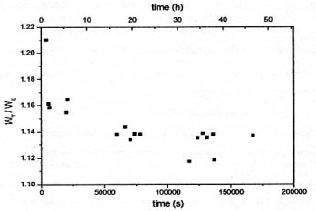The set of two pipes was used as a conductor through which a known electric current was allowed to flow from a dc generator. The potential difference, typically 5 V, across the pipes, as well as the current, were constantly monitored. The amount of heat produced in the pipes was measured by using a flow calorimeter. Water was flowing through the copper pipe, at a measured rate, and the temperature of pipes was allowed to reach a constant value (typically one hour) . The water temperature was measured at the input and at the output. The calorimetric parameters were then used to calculate Wt, the rate at which heat was generated. It turned out that Wt was higher that the rate at which electric energy was supplied, We (for example, 12 W at 5 V).

The excess heat ratio, defined as p=(Wt/We), was found to increase with the magnitude of the electric current. At the highest current used in the experiment the value of p was 1.21. A progressive decrease of p, attributed to a decrease of current during a two-days-long experiment, is illustrated in the figure. The values of p, in a steady state, are always larger than unity; the excess heat was never smaller that twelve percent of supplied energy.
My description of the apparatus was slightly simplified; the outer surface of the steel pipe was also cooled by circulated water and temperatures were measured in several different locations (to determine gradients). Furthermore, the system was equipped with a calibration solenoid; it was used to heat the pipes inductively rather than ohmically. The authors claim that the excess heat is not an artifact due to a systematic error; I am taking this for granted. What else can one do without having a possibility to examine the apparatus, and the procedures used to evaluate We and Wt? Speculations about the nuclear origin of excess heat were presented but I am ignoring them because no evidence was offered. This, however, should not be a justification for rejecting what has actually been established -- the excess heat.
In one experiment, lasting several days, the excess heat was 520 kJ. The authors argued that the oxidation of metals, which were only slightly tarnished, or any other chemical process, could not possible be responsible for a significant contribution to excess heat. The pipes would have to be 91% oxidized to release 520 kJ of chemical energy. Tarnishing, however, indicates that the oxidation affected only a small fraction of one percent of metals. That is why the chemical origin of the anomalous energy was rejected by the authors.
My summary is based on what has been published in the ICENES2002 proceedings (pages 367 to 373). The e-mail address of Jacques Dufour, listed in the proceedings, is dufourj@cnam.fr I attended the conference and had a chance of talking with Jacques after his presentation. He said that the attitude of French mainstream scientists toward the so-called “cold fusion” field is becoming more and more positive.